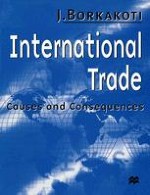1998 | Buch
Über dieses Buch
A rigorous and comprehensive text dealing primarily with the determinants of the pattern of trade gains from trade and trade policy. Spanning the old theories (the Ricardian hypothesis, the static and dynamic Heckscher-Ohlin model, the neofactor proportions and the neotechnology theories) it also contains the new theories (including various models of intra-industry trade and the dynamic models of endogenous growth and trade). Gains from trade and trade policy issues are comprehensively analysed. The various theories are presented verbally, geometrically and mathematically.
Anzeige
